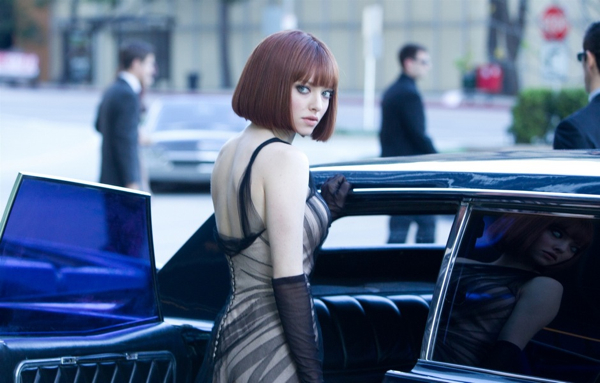Movie review by Greg Carlson
Writer-director Andrew Niccol’s “In Time” returns to the blend of science fiction, politics, and thrills seen in his 1997 cult debut “Gattaca,” but with considerably less punch and effectiveness. Niccol’s interest in social (in)justice as filtered through futurism, fantasy, or speculation has ranged from the critically lauded media critique of “The Truman Show,” which he wrote and produced, to the lousy, vapid, meta-narrative “Simone,” and “In Time” takes its place on his filmography somewhere between those poles. “In Time” hints at a richer, more complex examination of class, temporality, and the value of an individual’s life than the drama that unfolds.
Set in a free market dystopia where time has replaced money as the economy’s essential unit of currency, “In Time” follows the hardscrabble struggle of Will Salas (Justin Timberlake), a blue collar clock-puncher laboring to earn enough minutes to keep himself alive for another day. Luminescent, forearm-embedded countdown timers provide every citizen with urgent memento mori, but wealthy, leisure class moguls bank decades and centuries while ghettoized underclass paupers routinely drop dead when their stopwatches zero out. Like cash before it, time can be given, taken, traded, hoarded, and stolen.
In a nod to “Logan’s Run,” Niccol appends the premise that genetic engineering switches off physical aging to maintain each person’s physicality at the age of twenty-five, a choice that banishes older actors from the movie but reaps the unintended consequence of building a universe where it often looks like kids are playing dress up (Vincent Kartheiser is supposed to be Amanda Seyfried’s father, for example). Olivia Wilde, a few years Timberlake’s junior, plays his mother. While Niccol briefly flirts with the Oedipal subtext, the film pursues a different agenda, and the “forever young” gimmick evaporates.
References to the Occupy Wall Street movement pop up in several reviews of “In Time,” with both Melissa Anderson and Stephanie Zacharek opining that the movie is “for the 99 percent.” If that assumption is correct, the proletariat surely deserves a smarter story. Niccol’s stiff emphasis on the “Bonnie and Clyde” robberies Will commits with love interest Sylvia Weis (Seyfried) drains away precious moments that would be better spent sharpening the characters. Seyfried suffers the fate of so many before her, stuck playing a kidnapping victim who instantly falls in love with her captor. Flat “timekeeper” Cillian Murphy and thuggish senior citizen “minuteman” Alex Pettyfer are also underserved by Niccol’s heavy hand.
Like “Blade Runner,” “In Time” economizes on production costs by embracing the stylish retro-futurism pioneered in the former film, using vintage cars, architecture, and fashion to construct its vision of the world to come. Author Harlan Ellison, whose often-reprinted short story “’Repent, Harlequin!’ Said the Ticktockman” shares a number of basic similarities with “In Time,” attracted some minor publicity for the movie when he filed a lawsuit against the filmmakers, but Ellison’s own indebtedness to Orwell’s “Nineteen Eighty-Four” somewhat diminishes the claim in a genre teeming with time-focused stories and standard contrivances like the dehumanizing dangers of megacorporations and corrupt governments. Even though “In Time” isn’t hard-boiled enough to qualify as purist cyberpunk, it fulfills the genre’s preoccupation with “high tech and low life.”
